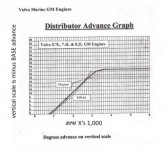hey guys i need some help, i am installing a new motor and i have it mounted on a pallet on a trailer for testing purposes, i have the manifolds risers and elbows in place. all new exhaust (sierra) and i am getting water in my oil. could the exhaust not being atached to the y pipe be sucking the water back into the cylinders? this is the 2nd time this is happened. the ist time i sent the engine back to the builder, i filled the manifolds with acetone and found no leaks, i had the intake pressure tested and no problems found.
the 2nd issue it the timing. i can not get the timing to within specs and sound right.
this rebuilt engine has a pertronix ignition in a pretrolte dist. no weights, just a shaft set up. basic.
the engine sounds the best at 22deg btdc, when i bring it to 8 deg, it runs rougher, not as smooth as 22. the vacuum gauge is very bouncy, violently bouncing from 16-22i in hg.
i have confirmed tdc with a piston stop and it lines up with the timing marks perfectly. what am i missing. i have never had an issue like this before and i am stumped
the engine has already been back to the builders and they claim there is no issue what so ever with it. so how do i ecplain the vascuum gauge dance and the timing issue?
if the water in the oil is caused by the manifold back pressure, whats the fix for that?
i know the truck cams have an overlap in the valves which could cause ewater to be sucked in so what to do?
i hope i can get some answers on this , thanks guys
the 2nd issue it the timing. i can not get the timing to within specs and sound right.
this rebuilt engine has a pertronix ignition in a pretrolte dist. no weights, just a shaft set up. basic.
the engine sounds the best at 22deg btdc, when i bring it to 8 deg, it runs rougher, not as smooth as 22. the vacuum gauge is very bouncy, violently bouncing from 16-22i in hg.
i have confirmed tdc with a piston stop and it lines up with the timing marks perfectly. what am i missing. i have never had an issue like this before and i am stumped
the engine has already been back to the builders and they claim there is no issue what so ever with it. so how do i ecplain the vascuum gauge dance and the timing issue?
if the water in the oil is caused by the manifold back pressure, whats the fix for that?
i know the truck cams have an overlap in the valves which could cause ewater to be sucked in so what to do?
i hope i can get some answers on this , thanks guys
Last edited:



